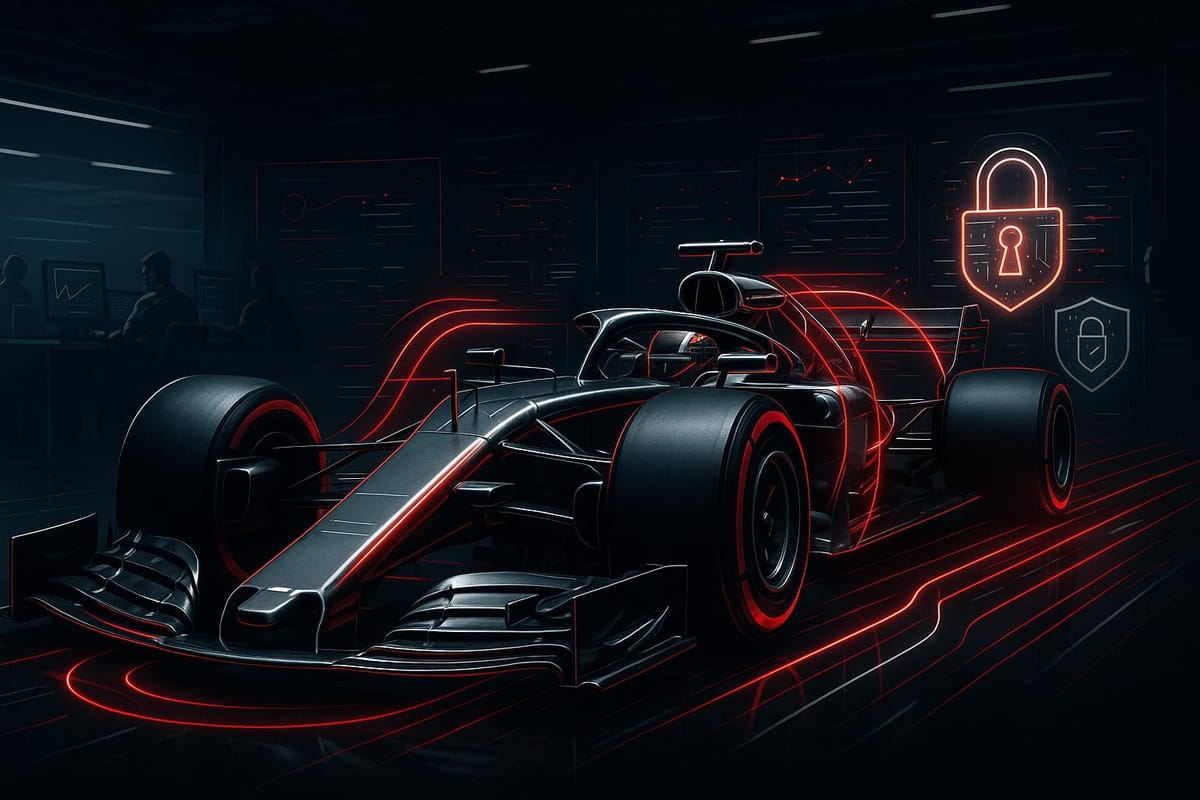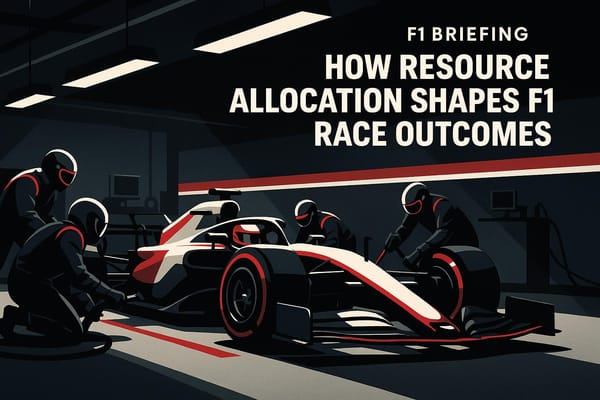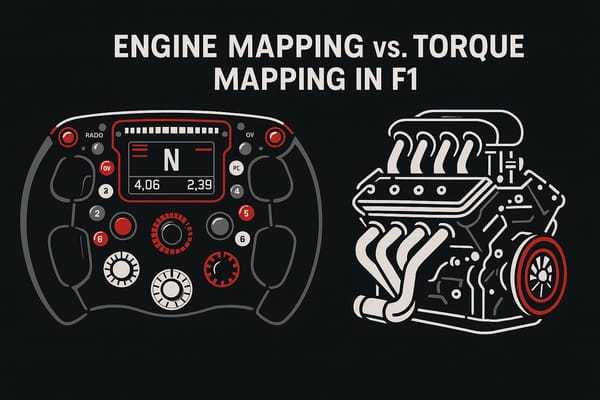How F1 Teams Secure Telemetry Data
Explore how Formula 1 teams protect telemetry data through encryption, AI monitoring, and strict access controls to secure their competitive edge.

Formula 1 teams handle 400 GB of telemetry data per event, making data security as critical as car performance. This data drives race strategies, pit stops, and car setups - but it’s also a target for cyberattacks. From encryption to real-time AI monitoring, F1 teams use advanced methods to protect sensitive information.
Key Takeaways:
- Encryption Everywhere: Teams encrypt data at every stage - car sensors, wireless transfers, and storage.
- AI for Threat Detection: AI systems monitor and respond to cyber threats in real time.
- Access Control: Role-based access and multi-factor authentication limit data exposure.
- Global Compliance: Teams navigate international data laws like GDPR and China’s PIPL.
- Secure Infrastructure: Hybrid cloud, dedicated communication channels, and physical backups ensure reliability.
Telemetry security isn’t just about protecting data - it’s about winning races. With every millisecond and gigabyte counting, F1 teams are in a constant race to stay ahead of cyber threats.
Former F1 Data Engineer Explains Race Telemetry | MoTeC [#TECHTALK]

Encryption Methods: Protecting Data During Transfer and Storage
In the high-stakes world of Formula 1, telemetry data is both a treasure trove of strategic insights and a potential vulnerability. Protecting this data is critical, especially given the sheer volume generated during races. Cars can produce anywhere from 100 kilobytes to 0.5 megabytes of data per second, streaming information through 1,000 to 2,000 telemetry channels - each one a potential target for interception. To combat these risks, F1 teams employ layered encryption to secure data at every stage, from the car itself to the pit wall and beyond.
Encryption in the Car
The first line of defense begins inside the car, where up to 300 sensors monitor key metrics like tire pressure and engine temperature. This information is processed and stored in the car's Electronic Control Unit (ECU) before being transmitted. As Evan Short, Team Leader of Trackside Electronics Systems at Mercedes F1, explains:
"Once we've gathered up the data on the car, everything is synchronized, so we know exactly what's happening at a precise time on each one of those sensors. The data is then encrypted and transmitted to the pits through our telemetry system."
To secure this real-time data stream, teams rely on the Advanced Encryption Standard (AES), which encrypts the data at its source. The stakes are immense: during a single Grand Prix weekend, teams can generate around 100 gigabytes of data, and over the course of a season, each car may produce 2 to 3 terabytes of ECU data.
Securing Wireless Data Transmission
Wireless data transmission is one of the most vulnerable points in the telemetry process. Data is transmitted from the car to the pit wall on a 1.5 GHz frequency or another approved frequency, with only a 2-millisecond delay between collection and reception. To protect this sensitive information, teams use end-to-end encryption, ensuring that data remains secure as it travels to the factory or cloud storage systems.
The FIA enforces strict guidelines on communication frequencies and encryption protocols, creating a standardized security baseline for all teams. These encryption measures also extend to physical data transfers within the garage, ensuring comprehensive protection at every stage.
Physical Data Transfer Methods
When cars return to the garage, teams connect them to "umbilical cords" for downloading detailed data - far more than what can be transmitted wirelessly. These wired connections allow teams to collect two to three times more data during a session. For example, a 90-minute practice session can yield 5–6 GB of raw compressed data from a single car. Although wired transfers are inherently more secure, teams still encrypt this data to guard against unauthorized access in the garage or on storage devices.
The scale of these physical data transfers is staggering. During the 2022 Mexico Grand Prix weekend, about 11 terabytes of data were exchanged between factories and trackside teams. By layering encryption methods for both wireless and physical transfers, F1 teams create a robust security framework, protecting their competitive edge in a fiercely competitive environment.
Building Secure Telemetry Infrastructure
Formula 1 teams depend on advanced systems to handle the immense flow of telemetry data during race weekends. With each car generating over 1 terabyte of data during a single weekend, these systems must securely transmit, process, and store information while ensuring real-time decisions aren’t delayed.
Dedicated Communication Channels
At the heart of secure telemetry is the use of dedicated communication channels designed to minimize interference and prevent unauthorized access. The FIA allocates specific communication frequencies to each team, creating isolated pathways that link the car to the pit wall. To comply with FIA regulations, teams are also required to maintain backup communication systems in case of telemetry failure.
Teams often rely on digital radio systems like TETRA or Kenwood NXDN Nexedge to ensure uninterrupted, low-latency data transmission. Transmission speeds vary, ranging from just 10 milliseconds at European races to as high as 300 milliseconds during flyaway events. Beyond secure transmission, centralized systems play a crucial role in organizing and managing this data effectively.
Centralized Data Management Systems
Secure transmission is only part of the equation. Centralized systems are essential for collecting, processing, and analyzing the enormous volumes of data generated during a race. For instance, McLaren Racing deals with petabytes of data during car design phases and terabytes over a single race weekend.
To streamline operations, Aston Martin Racing uses a NetApp FlexPod system, which has significantly reduced their trackside server setup to just two racks. This system processes data on-site and employs SnapMirror technology to take snapshots, sending only the differences to their Silverstone factory for simulations and testing.
In contrast, Oracle Red Bull Racing has embraced cloud technology. Through a $500 million partnership with Oracle Cloud Infrastructure, the team uses Oracle Container Engine for Kubernetes to containerize simulation applications. They run Monte Carlo models on high-performance Ampere Arm-based CPUs, enabling advanced race strategy simulations. As Christian Horner, CEO of Oracle Red Bull Racing, remarked:
"Oracle Cloud is playing a key role in the outcome of every single Grand Prix that we've won this year and every Grand Prix where we've achieved significant results."
Scuderia Toro Rosso takes a different approach with a portable data center featuring eight physical servers for redundancy and load balancing. Their system includes solid-state drives to withstand track vibrations and VMware fault tolerance to ensure uninterrupted telemetry data flow, even if one virtual machine fails.
Centralized systems also integrate tools like McLaren Applied’s ATLAS software, which allows teams to monitor live data during race weekends. Cars generate around 30 megabytes of live data per lap, with spikes occurring during pit stops.
Prioritizing Security and Efficiency
Role-based access control (RBAC) is a key feature of these systems, ensuring that only authorized personnel can access sensitive telemetry data. Teams also optimize storage by filtering out unnecessary data and implementing hot-warm-cold storage architectures to balance cost and efficiency.
Data protection is another critical area. For example, robust backup systems, including 60-terabyte servers and automatic power failover mechanisms, are standard. As Patrick Pulvermueller, CEO of Acronis, emphasized:
"Building in 'redundancy' and 'resiliency', according to Pulvermueller, are necessary, and 'mean-time-to-restore' is key where back-ups are deployed."
Meeting Global Data Regulations
While securing telemetry is essential for on-track strategies, navigating global data regulations is equally important. Formula 1 teams face a maze of international data protection laws as they transport telemetry data across borders during the racing season. With cars generating a staggering 400 GB of data per event, maintaining regulatory compliance isn't just about avoiding fines - it’s also about staying financially stable.
The rules vary widely across regions. For instance, Europe’s General Data Protection Regulation (GDPR) enforces strict data handling and limits on international transfers. Meanwhile, Singapore's Personal Data Protection Act (PDPA) sets privacy benchmarks for key F1 hubs. Perhaps the toughest to manage is China’s Personal Information Protection Law (PIPL), which mandates that certain data remain within the country.
As Douglas Goodridge, Chief Information Officer at Williams Racing, succinctly puts it:
"Data drives every decision in F1"
This reliance on data underscores just how critical - and challenging - compliance is for every team.
Data Classification and Sensitivity Levels
Each race generates 250 million data points, which teams classify by sensitivity. This ranges from public timing information to highly sensitive proprietary designs and biometric data. Teams typically follow a tiered classification system:
- Internal use only: Covers race telemetry data.
- Highly confidential: Includes financial records and strategic plans.
- Top-level security: Protects driver performance metrics and engineering insights due to their immense competitive value.
To safeguard this information, teams enforce targeted encryption and Role-Based Access Control (RBAC), ensuring only essential personnel have access.
Additionally, teams conduct Privacy Impact Assessments (PIAs) before transmitting data across borders. These assessments help identify risks and ensure adherence to regional privacy laws.
Regional Compliance and Localization
Operating across multiple jurisdictions forces F1 teams to adopt hybrid cloud solutions from providers like AWS and Microsoft Azure. These solutions combine local data storage with global cloud infrastructure, allowing teams to meet localization requirements while maintaining performance.
Ed Green, Head of Commercial Technology at McLaren Formula 1 Team, highlights the role of cutting-edge technology:
"As a racing team, we have high demands with connectivity at the edge, mobile data centers, and a high-performance workplace. We need to make sure we are utilizing the best technology, and that's why we rely on Cisco."
To further ensure compliance, teams sign secure processing agreements with third-party providers. These agreements include clauses that address regulatory requirements in every jurisdiction where data may be stored or processed.
Legal Frameworks for Cross-Border Data Transfers
Beyond regional compliance, F1 teams rely on international legal frameworks to manage cross-border data flows. Under GDPR, they use Standard Contractual Clauses (SCCs) and Binding Corporate Rules (BCRs) to safeguard personal data transfers outside the EU. These tools help maintain compliance with European privacy standards .
The complexity of global data governance continues to grow. A review of 134 studies highlighted issues like enforcement inconsistencies, legal mismatches, and differing interpretations of privacy laws, all of which make global compliance more challenging.
To counter these difficulties, teams employ encryption-in-transit protocols, particularly via fiber-optic links, ensuring intercepted data remains unreadable without the correct decryption keys.
Teams also conduct extensive cybersecurity audits of their suppliers. These audits verify that all partners meet stringent security standards, as a breach anywhere in the supply chain could lead to severe penalties, reputational damage, and potentially jeopardize sponsorships - an essential lifeline for financial success.
Real-Time Monitoring and Threat Detection
Once telemetry is secured with layered encryption and dedicated communication channels, the next critical step is detecting threats in real time. During race weekends, Formula 1 teams deal with an overwhelming amount of telemetry data. The need for immediate, real-time monitoring becomes non-negotiable. Traditional cybersecurity methods simply can’t keep up with the split-second decisions that can determine the outcome of a championship. That’s why F1 teams rely on artificial intelligence (AI) and machine learning (ML) to build systems that continuously monitor network activity, analyze patterns, and flag anomalies that might indicate a cyberattack.
The stakes couldn’t be higher. As Christian Horner, CEO of Oracle Red Bull Racing, aptly states:
"Data is in the team's lifeblood. Every element of performance – how we run a race, how we develop a car, how we select and analyze drivers – it's all driven by data."
To meet these demands, teams have turned to cutting-edge AI and ML tools that enable real-time threat detection and response.
AI and Machine Learning for Threat Detection
McLaren Racing has emerged as a standout example of how AI can transform cybersecurity. Using Darktrace's self-learning AI, the team can detect and respond to potential supply chain threats in real time. This AI system monitors behavioral patterns across the network, instantly flagging unusual activity from third-party vendors that might signal a breach.
Ed Green, Head of Commercial Technology at McLaren, explains:
"We've used a lot of machine learning and AI across [the cybersecurity] space... Now, through the use of a lot of machine learning and AI, we don't have as big a cybersecurity team, but they've got more relevant context, so they can see where the information is going, so embracing machine learning and AI is really important for us."
The results speak for themselves. AI-driven monitoring tools have cut end-to-end resolution times by 86%. For example, when engineers face system issues, generative AI can provide responses in as little as 5–10 seconds, reducing initial triage time from over a day to under 20 minutes.
Another innovation comes from AWS and Formula 1, which developed an AI-powered root cause analysis tool using Amazon Bedrock. During one race weekend, this system helped teams identify the root cause of web API system issues and implement a solution within just three days, including deployment and testing.
Lee Wright, Head of IT Operations at Formula 1, emphasizes its impact:
"With the RCA tool, the team could narrow down the root cause and implement a solution within 3 days, including deployments and testing over a race weekend. The system not only saves time on active resolution, it also routes the issue to the correct team to resolve, allowing teams to focus on other high-priority tasks, like building new products to enhance the race experience."
AI tools are also proving critical in identifying credential-based attacks, which account for 75% of initial access attacks that don’t involve malware. By analyzing typical user behavior, these systems can quickly detect when valid credentials are being misused.
FIA Oversight and Monitoring
While teams employ advanced AI to safeguard their networks, the FIA ensures the sport’s integrity through centralized, real-time monitoring. The FIA's Remote Operations Centre (ROC) acts as the central hub for telemetry oversight, earning the nickname "VAR for F1". The ROC receives live data from all cars, enabling officials to immediately spot irregularities like track limit violations or fuel-flow limit breaches.
To prevent data breaches, the FIA enforces secure communication protocols. Teams are also required to maintain backup communication systems to ensure uninterrupted monitoring in case of telemetry failures.
Fuel flow, for instance, is monitored using an FIA-mandated ultrasonic sensor that enforces a strict 100 kg/hour flow limit above 10,500 RPM. This sensor takes measurements 2,200 times per second to ensure precision. Similarly, sensors on DRS (Drag Reduction System) actuators verify that the wing fully opens or closes and returns to its preset position within 0.4 seconds of deactivation. If a malfunction occurs, such as the wing remaining partially open, the FIA can immediately order the car to pit for repairs.
This layered approach ensures a robust security framework. While teams focus on protecting their data from external threats, the FIA’s oversight guarantees the integrity of telemetry data, safeguarding both the sport’s competitive edge and its fairness.
Access Control and Authentication: Limiting Data Exposure
During a single race, an F1 car can generate a staggering 30 gigabytes of data from around 300 sensors. This data contains critical insights, like engine mappings and aerodynamic setups, which, if exposed, could give rivals a serious edge. That's why controlling access to this telemetry data is a top priority for teams, ensuring that only the right people see the right information.
The key to this lies in advanced access control systems, which limit data exposure based on each team member's role. By using a combination of role-based access and multi-factor authentication, teams can tightly manage who gets access to sensitive information.
Role-Based Access Control (RBAC)
One of the main tools F1 teams rely on is role-based access control (RBAC). This system ensures that team members only access the data relevant to their specific jobs. For example, a tire engineer doesn't need to see fuel strategy data, and a marketing team member has no reason to view engine telemetry. RBAC assigns permissions based on roles, allowing, say, a race engineer to monitor real-time telemetry while a data analyst focuses on historical trends. Meanwhile, team principals and technical directors often have broader access to make high-level decisions.
RBAC operates through digital keys that categorize data and restrict access accordingly. When someone tries to access telemetry data, the system evaluates their role and permissions, either granting or denying access based on predefined rules. This not only minimizes accidental exposure but also protects against insider threats.
Multi-Factor Authentication (MFA)
While RBAC defines who can access data, multi-factor authentication (MFA) ensures that only authorized individuals can log in. Passwords alone are no longer enough, especially with the rise of remote access to critical systems. According to Microsoft telemetry, over 99.9% of compromised Azure AD accounts lacked MFA.
MFA adds layers of verification, requiring team members to prove their identity using multiple credentials - something they know (like a password), something they have (such as a security token or smartphone), and sometimes something they are (like a fingerprint or facial recognition). This approach blocks nearly 99% of automated account takeover attempts.
F1 teams enforce MFA across all platforms, from trackside systems to cloud-based analysis tools, ensuring strong defenses against unauthorized access. The Cybersecurity and Infrastructure Security Agency (CISA) also recommends using phishing-resistant MFA to combat increasingly sophisticated credential attacks.
Secure Cloud Storage Solutions
To manage the immense amount of race data securely, F1 teams are turning to hybrid cloud storage solutions. These systems balance security with scalability, providing encrypted storage and real-time threat detection. For example, McLaren Racing uses Darktrace's AI to monitor supply chain risks while safeguarding telemetry and strategy data in encrypted cloud environments. Similarly, Oracle Red Bull Racing uses Oracle's cloud infrastructure for both storage and analysis. As Christian Horner, CEO of Oracle Red Bull Racing, explains:
"Oracle Cloud is playing a key role in the outcome of every single Grand Prix that we've won this year and every Grand Prix where we've achieved significant results."
Other teams use platforms like AWS and Microsoft Azure, which offer hybrid options that combine cloud and local storage. These providers include built-in security tools like AWS Shield and Microsoft Defender for Cloud to protect against DDoS attacks and unauthorized access. Teams also classify their data based on sensitivity, applying encryption and tokenization to ensure that only authorized personnel can access critical information.
Conclusion: The Future of Telemetry Data Security in F1
In today’s Formula 1, protecting telemetry data is as critical as fine-tuning aerodynamics or maximizing engine performance. Each car churns out an astonishing 35 megabytes of raw telemetry data during a single two-minute lap. This treasure trove of information is the backbone of a team’s strategy, influencing everything from pit stops to race-day decisions.
New technologies are shaping the future of telemetry security. For instance, AI and machine learning have demonstrated incredible potential, with recent studies showing they can achieve intrusion detection accuracies of 99.7%, far surpassing the 92% achieved by traditional methods. Self-learning AI systems take this a step further, enabling real-time responses to potential threats. These advancements are setting the stage for even more sophisticated and resilient systems.
Teams are also experimenting with cutting-edge solutions like quantum-safe encryption to prepare for the next wave of cyber threats. In parallel, hybrid telemetry systems are being developed, blending multiple transmission methods - such as 5G, satellite-assisted telemetry, and enhanced infrared technology. These innovations aim to ensure uninterrupted real-time data flow while reinforcing communication security.
Regulations and expertise will play a key role in shaping the sport’s data security landscape. The FIA is expected to implement stricter rules to protect race data integrity and prevent digital tampering that could unfairly influence outcomes. At the same time, teams will need to cultivate specialized cybersecurity skills, particularly in areas like AI security, cloud protection, and quantum-safe cryptography.
The stakes are enormous. Past breaches have highlighted how catastrophic data vulnerabilities can be, driving the current focus on robust safeguards. As Douglas Goodridge, Chief Information Officer at Williams Racing, aptly put it:
"Data is the forefront of everything we do, F1 is a data driven sport."
- Douglas Goodridge, Chief Information Officer, Williams Racing
With each event generating a staggering 400 gigabytes of data, teams must find the perfect balance between speed, accessibility, and security. The path to victory will no longer hinge solely on having the fastest car but also on building the most secure and dependable data infrastructure to support it. In Formula 1, the margin for error is razor-thin, and the race to protect data is just as intense as the battle on the track.
FAQs
How do Formula 1 teams protect telemetry data from cyber threats during international races?
Formula 1 teams go to great lengths to safeguard their telemetry data during international races, leveraging advanced cybersecurity measures and strict protocols. They use encryption to secure the data and classify it based on its sensitivity. For instance, car performance metrics and driver biometrics are treated with the highest level of protection. Some telemetry data might be marked for internal use only, while more sensitive details are given even tighter security controls.
To navigate the complexities of global data regulations, teams utilize hybrid cloud systems. These systems allow them to store data locally when necessary, ensuring compliance with regional laws. Before moving data across borders, teams perform thorough Privacy Impact Assessments (PIAs) and adhere to frameworks like Standard Contractual Clauses (SCCs). This approach keeps telemetry data secure, reliable, and readily available for real-time decisions during the high-pressure environment of Formula 1 races.
How does AI help Formula 1 teams protect telemetry data during races?
AI plays a key role in protecting telemetry data in Formula 1 by continuously monitoring and analyzing the enormous flow of information generated by the cars during a race. With advanced algorithms at its core, AI can spot unusual patterns or irregularities that might signal potential security threats - even when the exact nature of the threat is unknown.
This ability to learn and adapt on its own enables teams to react swiftly to new risks, keeping sensitive data secure and trustworthy throughout the competition. By using AI, F1 teams can strengthen the security and accuracy of their telemetry systems, providing a critical advantage in the fiercely competitive world of motorsport.
Why is encryption essential for protecting telemetry data in Formula 1?
Why Encryption Matters in Formula 1 Telemetry
In Formula 1, encryption plays a key role in keeping telemetry data secure. This data includes highly sensitive details like car performance stats and strategic plans - information that teams cannot afford to have fall into the wrong hands. By encrypting data at every stage - whether it’s being collected, transmitted, or stored - teams can shield it from cyber threats and ensure it remains confidential.
The importance of encryption becomes even more apparent during races. Real-time telemetry data is critical for making split-second decisions that can make or break a team’s performance. Encryption not only safeguards this data from unauthorized access but also ensures smooth communication between the car and the pit crew. This uninterrupted flow of information helps teams stay competitive while also adhering to strict data protection regulations. Without encryption, the risk of data breaches or compromised strategies could have a serious impact, both on race day and beyond.




